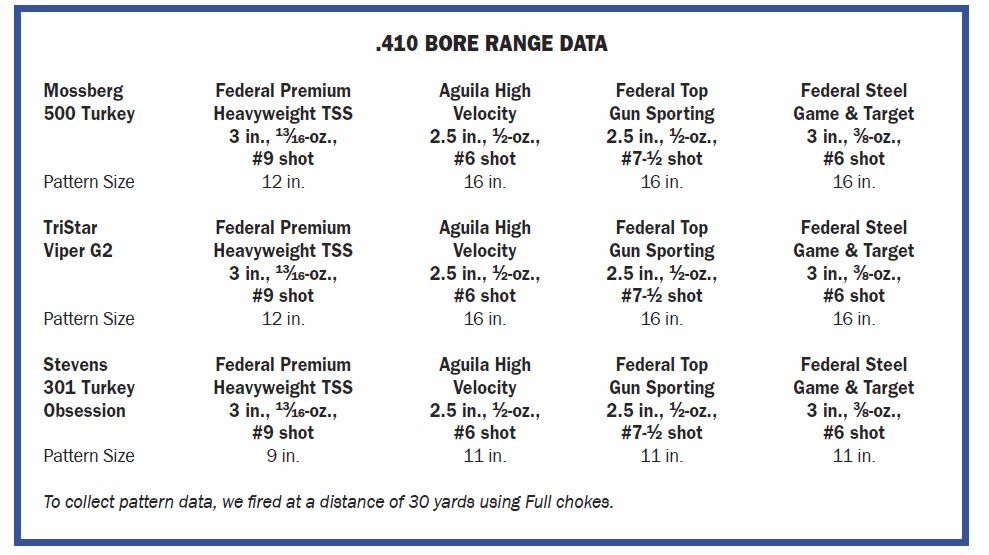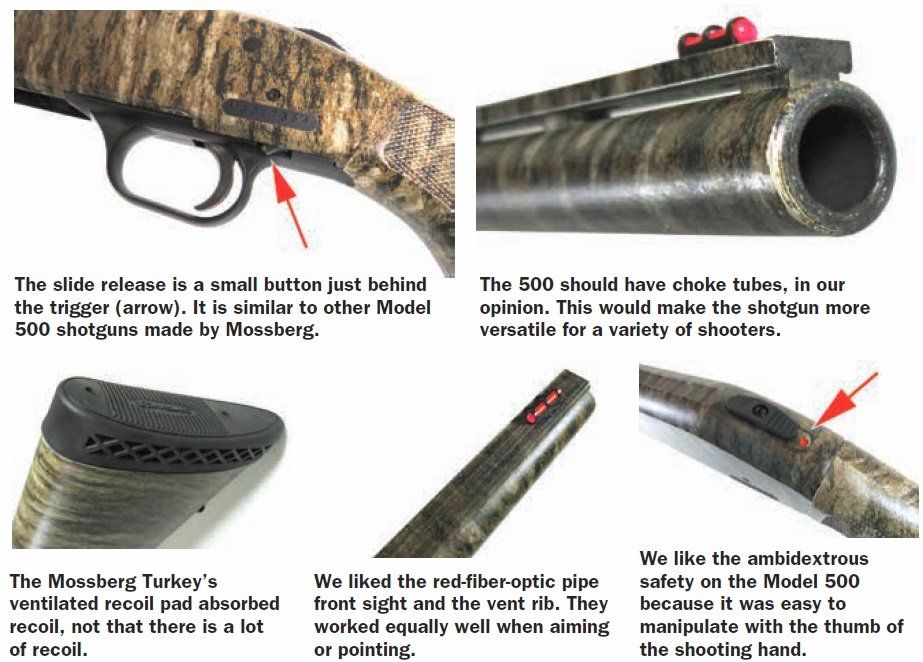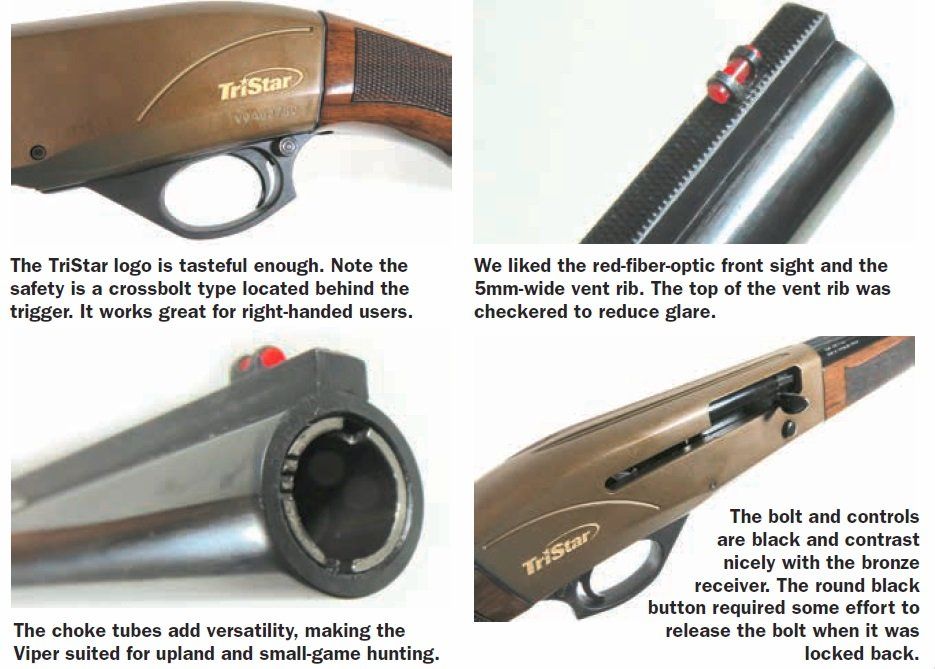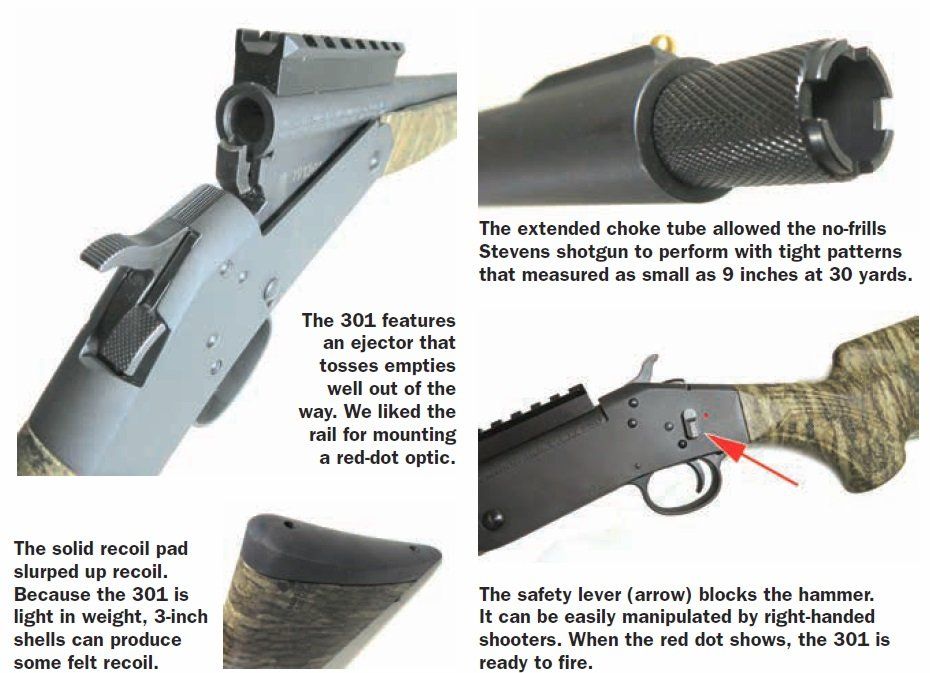While most turkey hunters think a 12-gauge shotgun loaded with 3.5-inch shells is the optimum set up for turkey — and we think it is, too — newer sub-gauge shotguns can get the job done if you are up for the challenge. It’s not all marketing hype, as we discovered. We tested three brands of shotguns — Mossberg, TriStar, and Stevens — with a variety of .410-bore loads to determine if a .410 was a viable option for turkey hunting. in our opinion, yes and no. It all depends on the shotshell load and the distance to the tom. Even with a 3.5-inch 12-gauge load, a shot is not necessarily a slam dunk. That’s why it’s called turkey hunting and not turkey shooting.
We’ve tested a number of newer .410 defense loads in the recent past and found these loads can make an excellent impression on a bad actor determined to do you harm. As the new defense loads have been developed, so have hunting and target loads. While the .410 may not be as popular as 12- and 20-gauge shotguns, technology has a way of eventually reaching into all bores and gauges. Recently, Savage announced the release of a new .410 shotgun paired with a .410 load, all designed for turkey hunting. What? A .410 turkey load? So, with the thought of dispelling the silliness Savage is suggesting with a .410 turkey gun, we procured the new Savage and two other .410 shotguns. Our test shotguns included:
- the Savage/Stevens Model 301 Turkey Obsession 19253 break-action single shot;
- the Mossberg Model 500 Turkey 50109 pump repeater; and
- the new TriStar Viper G2 Bronze 24181, a semi-automatic repeater.
While the TriStar Viper G2 Bronze is not a camo finish, TriStar does import full-camo models, or the owner could install his own camo tape if he needed to. We felt these three guns were a good assortment of current .410-bore shotguns and at a variety of prices points, with the Stevens being inexpensive, the TriStar at the high end, and the Mossberg squarely in the middle. We also chose these three models to look at the various actions available and because the actions were scaled down to the .410 shell, so there was not a lot of extra weight on the guns. They all feel petite in hand, as if they had been shrunk.
We found the ammunition was an important consideration. Since .410 guns are generally considered an expert’s gun, they don’t provide a lot of wiggle room if you are slightly off target. Many well-intentioned shooters feel the .410 makes a great first shotgun, and that can be true only if the new shooter is adept at shooting. The .410 bore can be difficult to use, even for expert wingshooters. A .410 has limited resources, meaning it has fewer pellets than a 12 or 20 gauge. It does provide much less recoil than a 12 and 20, so they could be well suited for recoil-shy shooters, though we suggest if you do use these .410s for turkey hunting, know the shell’s limitations. We tested at 30 yards, and in our pinion, that is pushing the outer edge of the .410’s killing capability. We did, however, see some nice, dense patterns at 40 yards as we warmed up, but 30 yards and under would be our range with these guns. These guns are also lightweight, so 3-inch shells do produce some recoil. Start off with 2.5-inch shells for recoil-phobic shooters.
How We Tested
We tested on pattern density and ease of use. While we concentrated on testing these guns for turkey hunting, we also looked at how well they might work for dove season and further looked at pointability, balance, and swing. To get a sense of shot patterns and pellets in the kill zone, we placed turkey-head targets at 30 yards. We also fired the shotguns at clay pigeons flung from a hand thrower.
We assembled a variety of .410 shotshells: 3-inch Federal Premium Heavyweight TSS rounds, which were 13⁄16-ounce in weight with #9 shot; Aguila High Velocity, 2.5-inch, 1⁄2-oz., #6 shot; Federal Top Gun Sporting, 2.5-inch, 1⁄2-oz., #71⁄2 shot; and Federal Steel Game & Target 3 inch, 3⁄8-oz., #6 shot. We felt this was a good assortment of traditional lead, steel, and tungsten-alloy materials and shot and shell sizes.
The Federal Premium Heavyweight TSS is loaded to a factory muzzle velocity of 1100 fps. Federal uses a tungsten alloy that is denser than other tungsten loads and 56 percent denser than lead. That’s important since the pellets need speed downrange to effectively kill a bird. We found this load to pattern densely at 30 yards and would use it for hunting turkeys. We also found the Federal Steel Game & Target 3-inch 3⁄8-ounce with steel #6 shot to pattern well but not as densely as the TSS at 30 yards. The Aguila High Velocity use a 2.5-inch shell and 1⁄2-ounce of lead #6s, and Federal Top Gun Sporting uses a 2.5-inch shell and 1⁄2-ounce of lead #71⁄2 shot. The Federal load has a factory velocity of 1330 fps, and the Aguila has a factory muzzle velocity of 1100 fps. So these two shells are closely matched. We also found them to be quite effective on clay pigeons.
What we found was the combination of choke and shell really determined which shotgun was deemed best suited for turkey hunting. We felt all three could be employed effectively, but in our opinion, the Stevens was the best suited, followed by the TriStar and then the Mossberg. We would use the TSS load exclusively for turkeys, since it provided the best density through each of the shotguns tested. Holding a bead on a tom as you call him in close is the challenge with these .410 guns and a challenge some of our test teams would gladly accept. For wingshooting the TriStar excelled, followed by the Mossberg and then the Stevens. Both the federal and Aguila shells worked well, but know your range. Shooting doves with an open choke 12 gauge tests some shooters’ wingshooting skills and a .410 leaves very little room for error.
We cranked through a lot of .410 shells while testing and don’t have a sore shoulder to prove it, so here’s what we learned about .410-bore turkey guns.

Mossberg Model 500 Turkey 50109 .410 Bore, $303
GUN TESTS GRADE: B+

This M500 had a smooth-operating slide, nice Mossy Oak Bottomland camo finish, and offered light to minimal recoil. We would have liked chokes tubes instead of a fixed choke.
Action Type |
Pump |
Chamber Size |
3.0 in. |
Overall Length |
45.75 in. |
Capacity |
5+1 (2.5-in. shells), 4+1 (3-in. shells) |
Weight Unloaded |
6.5 lbs. |
Weight Loaded |
7.3 lbs. |
Barrel Length |
26.0 in. |
Barrel |
MO Bottomland camo finish, steel, vent rib |
Receiver |
MO Bottomland camo finish, alloy |
Choke |
Fixed, F |
Buttstock LOP |
13.87 in. |
Buttstock |
Textured polymer, ventilated recoil pad, sling studs |
Forend |
Textured polymer |
Sights |
Red-fiber optic tube |
Trigger Pull Weight |
6.06 lbs. |
Safety |
Ambidextrous thumb |
Warranty |
Limited lifetime |
Telephone |
(800) 363-3555 |
Website |
Mossberg.com |
Made In |
USA |
This was a recent price at CheaperThanDirt.com. The mid-priced Mossberg 500 Turkey pump is built on a receiver scaled for the .410. This is a pump-action repeater that uses Mossberg’s renowned Model 500 dual-bar action, which is smooth, and if you ever spent time with a Model 500, a bit loose. The forend wiggles a bit, which we have found on nearly every Mossberg Model 500 we have ever tested. The stock is polymer with molded-in checkering at the pistol grip, and the butt is fitted with a ventilated recoil pad to suck up any recoil. The forend is thin in hand and shaped so it is easy to grip the slide and pump the action. The trigger group is black polymer and not camo finished. The safety is black plastic and ambidextrous. It worked easy under your thumb. The 26-inch barrel sports a vent rib and a red-fiber-optic-pipe front sight. There is a bead at mid rib, and it is black and unnoticeable. Just as well because the red optic is what you want to focus on for either aiming at a turkey or pointing at a dove. The barrel has a fixed choke, and we feel this does not provide the Mossberg the most versatility. We would have preferred choke tubes.
The entire shotgun has a Mossy Oak Bottomland camo finish that was well executed. The seam could be seen on the underside of the barrel and magazine tube where the camo film meets. We noticed the camo finish was scratched by the fore end because it wiggled and rubbed up against the barrel. The 500 also is equipped with sling swivels, which are helpful on a turkey gun for affixing a sling.

The trigger had a 6.06-pound pull weight, which was much too heavy, in our opinion. When you have a heavy trigger pull and lightweight gun, they tend to work against each other. The Mossberg was the heaviest of the shotguns tested at 6.5 pounds unloaded. Recoil was extremely pleasant due to the weight and the soft-rubber recoil pad. The LOP was under 14 inches, so it felt like a smaller shotgun but was still comfortable to shoot even for our tall-stature testers.
We achieved our tightest patterns — 12 inches — with the Federal TSS shotshells, but they were not as tight at the Stevens. The other loads patterned a consistent 16 inches at 30 yards. We would have liked choke tubes. The barrel wall is thick enough, and we feel Mossberg should consider adding choke tubes since it would make this 500 more versatile for turkey and wing shooting. The Mossberg swung well enough on clay pigeons, and we enjoyed dusting hand thrown targets with it.
The 500 was easy to load, though the .410 shells, due to their narrow diameter, take a bit more finesse to insert into the magazine tube. The ejection port is small, but it was easy to load shells one at a time. The tiny 500 ran well, and we enjoyed shooting it.
Our Team Said: The 500 Turkey is a good pump repeater. The lack of choke tubes made this gun less desirable. The trigger was heavy. We’d take it turkey hunting with the TSS shells, but we make sure the bird was close enough. We’d also take this one dove shooting.
TriStar Viper G2 Bronze 24181 .410 Bore, $667
GUN TESTS GRADE: A-

This Viper G2 ran on all types of loads. It swung and pointed well and would do well in the dove field as well as on turkeys with the right load. We liked the choke tubes instead of a fixed choke.
Action Type |
Gas-operated, semi-automatic |
Chamber Size |
3.0 in. |
Overall Length |
48.25 in. |
Capacity |
5+1 (2.5-in. shells), 4+1 (3-in. shells) |
Weight Unloaded |
5.8 lbs. |
Weight Loaded |
6.4 lbs. |
Barrel Length |
28.0 in. |
Barrel |
Blued steel, vent rib |
Receiver |
Bronze-anodized alloy |
Choke |
3 choke tubes, flush fit Beretta Mobil style, IC/M/F |
Buttstock |
Checkered walnut, gloss, solid recoil pad |
Buttstock LOP |
14.38 in. |
Forend |
Checkered walnut, gloss |
Sights |
Red-fiber-optic tube |
Trigger Pull Weight |
6.1 lbs. |
Safety |
Crossbolt |
Warranty |
5-year limited |
Telephone |
(816) 421-1400 |
Website |
TriStarArms.com |
Made In |
Turkey |
This was a recent price at BudsGunShop.com. The Viper G2 is a refined shotgun for the price point compared to other semi-autos. It is also the most expensive shotgun in this test, but in our opinion, it is worth the cost. The Viper G2 is a gas-operated semi-auto manufactured in Turkey by Armsan. We wanted to test a camo model to keep with the turkey hunting theme, but could only get the Viper G2 Bronze. Not a bad trade-off in our eyes, though the full camo model is available and with sling studs and for about $150 less. The Bronze model has a bronze weather-resistant Cerakote receiver that we thought looked sharp, even with the TriStar logo laser engraved on both sides. The 28-inch chrome-lined barrel is blued steel and features a 5mm-wide vent rib, three choke tubes, and a red-fiber-optic-pipe front sight. The removable choke system uses Beretta/Benelli Mobil threads and includes three choke tubes (IC, M, F), choke box, and wrench. There is also a magazine plug installed by the factory to limit capacity. It can easily be removed.
The Viper G2 sports high-gloss Turkish walnut with machine-cut checkering. The wood looked nice, and wood-to-metal fit was tight. The buttstock had a well-fitted rubber recoil pad with a hard insert at the heel to slide smoothly over clothing. It also comes with a shim kit so you can fine-tune the drop and cast to fit the shooter’s stature.
The trigger group is black plastic. The safety is a crossbolt design located behind the trigger. It’s in a good place if you are a right-handed shooter. The ejection port is large enough for fumble-free insertion of a tiny .410 shell. The magazine port on the bottom of the receiver is wide enough to comfortably allow an adult-size thumb to push shells into the magazine tube.

The G2 features a magazine cutoff that allows a user to unload a chambered shell while retaining shells in the magazine. To use the cut off, press upward on the elevator while retracting the operating handle. The bolt will travel far enough to eject the loaded shell but will not lock back. To lock the bolt rearward, press the small plunger at the front of the trigger guard, which allows the elevator return to its lowest position.
The trigger was a bit on the heavy side with an average pull weight of 6.1 pounds. What we did like about the trigger was that it was crisp with no take-up.
The gas-operated action is similar to Italian-style operating systems; it is a large spool-shaped piston pushing against a two-armed slide. When fired, gas exits the barrel through two ports and forces the piston, slide and bolt assembly rearward, lowering the locking block. This lets the assembly recoil, eject the empty and pick up a fresh shell on the return. What separates the TriStar from other .410 semi-autos is there is only one piston. There is no need to swap out the piston to match the load. We found the Viper worked well with light and high-velocity loads.
In hand, the Viper G2 feels lively. It is lightweight, so it is easy to swing and point. Again, we found the TSS shell provided the most dense patterns at 12 inches. Other loads produced a consistent 16-inch pattern. If we owned this shotgun we’d try a JEBS “HeadHunter” extra full extended choke tube ($100; JebsChokes.com) or some similar extended choke tube to tighten the pattern and provide us more confidence with shots at our outer range. The Viper G2 ran smoothly. We liked this shotgun a lot on hand-thrown targets. We mixed shells during testing in an effort to trip up the gas system, but it ran well. Recoil was virtually non-existent.
Our Team Said: If you are looking for a fun-to-shoot .410 that’s quite capable of turkey hunting and dove hunting, the TriStar is an excellent option. We’d opt for a tighter choke tube for turkey hunting and stick with TSS shells.
Stevens Model 301 Turkey Obsession 19253 .410 Bore, $179
GUN TESTS GRADE: A-

This 301 is a stripped-down, simple-to-use shotgun designed for turkey hunting, albeit with the proper loads. We liked the rail for mounting a red dot, its light weight, and price.
Action Type |
Break action, manual hammer, single-shot |
Chamber Size |
3.0 in. |
Overall Length |
41.5 in. |
Capacity |
1 |
Weight Unloaded |
5.07 lbs. |
Weight Loaded |
5.15 lbs. |
Buttstock |
Textured synthetic, Mossy Oak Bottomland camo, solid recoil pad, sling studs |
Buttstock LOP |
13.75 in. |
Forend |
Textured synthetic, Mossy Oak Bottomland camo |
Barrel Length |
26.0 in. |
Barrel |
Blued, steel |
Receiver |
Blued, steel |
Choke |
1 choke tube, extended, F |
Sights |
Brass bead, optic rail |
Trigger Pull Weight |
5.4 lbs. |
Safety |
Manual hammer block |
Warranty |
1-year limited |
Telephone |
(800) 370-0708 |
Website |
SavageArms.com |
Made In |
China |
This was a recent price at BassPro.com. The Stevens was the reason for this .410 test. It is a barebones single-shot break action manufactured in China. It reminded our testers of a variety of American-made single-shot shotguns made by H&R, Stevens, Savage and others in the mid- to late-20th century. These old-time guns and Model 301 are in the no-frills category of shotguns. The looks won’t impress, but the dense patterns it shoots will.
The metal has a matte-black finish that is well executed. The 26-inch barrel has a brass-bead front sight. It also has a rail so a user could easily mount a red-dot scope. The barrel also features an extended Full choke tube. The tube is knurled and comes with a key to remove it.
The buttstock is polymer with Mossy Oak Bottomlands camo finish. A solid rubber buttpad is fitted quite well to the plastic stock. The fore end is also polymer and camo. It attaches and is removed via a button at the very front of the fore end. The stock and fore end are checkered, and sling studs are included.
Similar to an H&R action, the Stevens 301 has a checkered button on the right side of the receiver. Depress the button to open the action. The action on the 301 was as stiff as a pair of new, unwashed denim jeans. And like jeans, as we used the 301, it started to loosen up, but still required you to open the action with two hands and close it with two hands. The hammer is manual and must be thumbed back to fire the shotgun. The spur is serrated, and it takes a bit of effort to cock it back. With the hammer cocked back, you cannot open the action. The hammer needs to be fully forward to open the action.

On the left side of the receiver is a manual safety that blocks the hammer. It can easily be rotated with a right-handed shooter’s thumb. A red dot appears, indicating the 301 is ready to fire. The trigger is crisp with no take up, and it broke at 5.4 pounds on average. It was the best trigger of the three shotguns tested. The trigger guard was black plastic.
In hand, the 301 feels tiny. The LOP was slightly smaller than the typical shotgun and that was fine for adults. Kids and small-stature shooters will still have to reach for the trigger. We thought the brass bead was fine, but would have preferred a red fiber optic. We did like the rail, and if we owned this shotgun, we would mount a red-dot sight and dial it in with the TSS load. We were impressed that this sub gauge could pattern as tightly as a 9-inch pattern on average. We counted more pellets in the kill zone with the 301 using TSS shells than the other shotguns, and that gave us the confidence the 301 paired with TSS ammo would get the job done. The other loads produced consistent 11-inch patterns at 30 yards. In fact, one tester wanted to purchase the 301 to further test the 301 on an actual hunt.
Wingshooting with the 301 showed the rudimentary nature of the gun. No vent rib, no red fiber optic, and very whippy, with some of us pulling through the target far too early at first. We eventually got into a rhythm with the 301. It would not be our first choice to bring to the dove field, though if pushed it could do an okay job.
Follow up shots were slow with the 301, and we ended up shooting it like a dangerous-game double gun. In our support hand, we held a fresh shell between our fingers as we grasped the fore end so reloads were a bit faster. The 301 uses an ejector system that launched empty shells a few feet away.
Our Team Said: The 310 was the smallest and lightest of the three guns tested. In our opinion, the no-frills 301 allows you to concentrate on the hunt, calling in a tom closer. The shotgun worked quite well for a century old design. We think if you are dead set on trying the 410 for turkey hunting, the 301 is an inexpensive way to go.
Special thanks toEastern Outfitters(EasternOutfitter.com)of Hampstead, NC, for their assistance.
Written and photographed by Robert Sadowski,using evaluationsfrom Gun Teststeam testers.

























